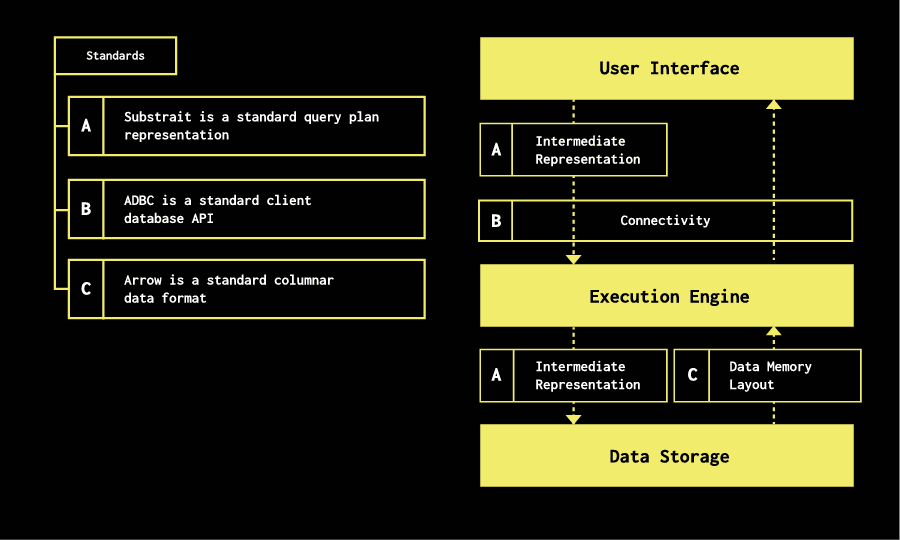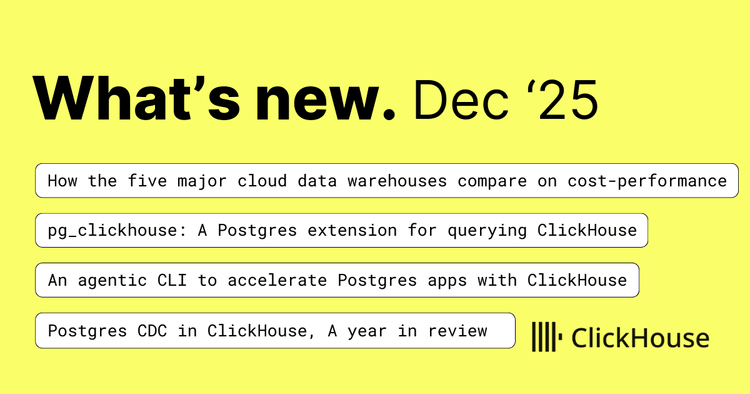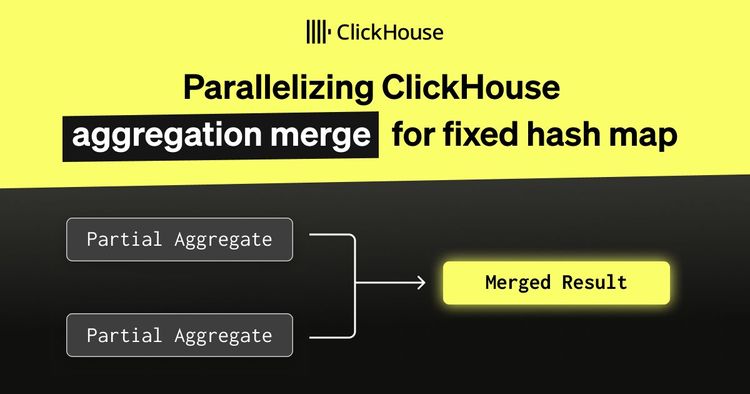Ibis is an open-source data frame library designed to work with any data system. It supports 20+ backends, including Polars, DataFusion, and ClickHouse. It provides a Pythonic interface that supports relational operations translated to SQL and executed on the underlying database.
In this blog post, we will learn how to use Ibis with ClickHouse.
The Composable Data ecosystem #
Ibis is part of what’s known as the composable data ecosystem. A diagram is shown below:

In the diagram, Ibis is the user interface. Unlike most other DataFrame libraries, Ibis uses SQL as its intermediate representation language, making it easier to communicate with different backends.
Installing Ibis and ClickHouse #
Let’s start by installing Ibis, its examples, and ClickHouse.
pip install 'ibis-framework[clickhouse,examples]'
We’ll start a ClickHouse Server if we don’t already have one running:
curl https://clickhouse.com/ | sh
./clickhouse server
Once ClickHouse is running, we’re ready to begin!
Importing an Ibis example dataset into ClickHouse #
Ibis comes with various example datasets. We’re going to import the nycflights13_flights dataset into ClickHouse.
We’ll first import Ibis and create a connection to ClickHouse:
import ibis
from ibis import _
con = ibis.connect("clickhouse://")
If we wanted to use a ClickHouse server running elsewhere, we could provide the URL and any credentials as part of the connection string. The next step is to create the table:
con.create_table(
"flights",
ibis.examples.nycflights13_flights.fetch().to_pyarrow(),
overwrite=True
)
This command imports the dataset into a table called flights and replaces the table if it already exists.
In another tab, let’s connect to ClickHouse to see what this command has done:
./clickhouse client -m
ClickHouse client version 24.7.1.2215 (official build).
Connecting to localhost:9000 as user default.
Connected to ClickHouse server version 24.7.1.
Once it’s connected, we can get a list of the tables:
SHOW TABLES
┌─name────┐
1. │ flights │
└─────────┘
1 row in set. Elapsed: 0.002 sec.
Exploring the Ibis flights dataset #
Let’s have a look at what fields we’ve got in that flights table:
DESCRIBE TABLE flights
SETTINGS describe_compact_output = 1
Query id: 7d497dee-ea8d-4b07-8b32-3f32f775ca32
┌─name───────────┬─type────────────────────┐
1. │ year │ Nullable(Int64) │
2. │ month │ Nullable(Int64) │
3. │ day │ Nullable(Int64) │
4. │ dep_time │ Nullable(String) │
5. │ sched_dep_time │ Nullable(Int64) │
6. │ dep_delay │ Nullable(String) │
7. │ arr_time │ Nullable(String) │
8. │ sched_arr_time │ Nullable(Int64) │
9. │ arr_delay │ Nullable(String) │
10. │ carrier │ Nullable(String) │
11. │ flight │ Nullable(Int64) │
12. │ tailnum │ Nullable(String) │
13. │ origin │ Nullable(String) │
14. │ dest │ Nullable(String) │
15. │ air_time │ Nullable(String) │
16. │ distance │ Nullable(Int64) │
17. │ hour │ Nullable(Int64) │
18. │ minute │ Nullable(Int64) │
19. │ time_hour │ Nullable(DateTime64(6)) │
└────────────────┴─────────────────────────┘
So far, so good. Let’s return to our Python REPL and explore the flight data more thoroughly. First, we’ll create a reference to the table:
flights = con.table("flights")
flights.schema()
ibis.Schema {
year int64
month int64
day int64
dep_time string
sched_dep_time int64
dep_delay int64
arr_time string
sched_arr_time int64
arr_delay int64
carrier string
flight int64
tailnum string
origin string
dest string
air_time string
distance int64
hour int64
minute int64
time_hour timestamp(6)
}
And now, let’s have a look at one row of the table:
flights.head(n=1).to_pandas().T
0
year 2013
month 1
day 1
dep_time 517
sched_dep_time 515
dep_delay 2
arr_time 830
sched_arr_time 819
arr_delay 11
carrier UA
flight 1545
tailnum N14228
origin EWR
dest IAH
air_time 227
distance 1400
hour 5
minute 15
time_hour 2013-01-01 10:00:00
The dep_delay and arr_delay have numeric data despite having the string data type. We can fix that in Ibis by casting those fields to the int type.
Keep in mind that this won’t change the underlying type in the database.
flights = (flights.mutate(
dep_delay = _.dep_delay.cast(int).coalesce(0),
arr_delay = _.arr_delay.cast(int).coalesce(0)
))
Next, let’s try to write some queries against the flights table. We’re going to put Ibis in interactive mode before we do this by setting the following parameter:
ibis.options.interactive = True
This parameter does the following:
Show the first few rows of computing an expression when in a REPL.
Let’s start by working out which airport has the most incoming flights:
(flights
.group_by(flights.dest)
.count()
.order_by(ibis.desc("CountStar()"))
.limit(5)
)
┏━━━━━━━━┳━━━━━━━━━━━━━━━━━━━━┓
┃ dest ┃ CountStar(flights) ┃
┡━━━━━━━━╇━━━━━━━━━━━━━━━━━━━━┩
│ string │ int64 │
├────────┼────────────────────┤
│ ORD │ 17283 │
│ ATL │ 17215 │
│ LAX │ 16174 │
│ BOS │ 15508 │
│ MCO │ 14082 │
└────────┴────────────────────┘
Chicago O’Hare wins on this metric. We could rewrite this query using the agg function to read like this:
(flights.group_by(flights.dest)
.agg(flightCount = _.count())
.order_by(ibis.desc(_.flightCount))
.limit(5)
)
Or we can simplify it by using the topk function:
flights.dest.topk(k=5)
The topk function only works if we want to group by a single column. If we're going to group by multiple columns, we still need to use the agg function.
If we want to see the underlying SQL executed when we run this code, we can use the ibis.to_sql function:
print(ibis.to_sql(flights.dest.topk(k=5)))
SELECT
*
FROM (
SELECT
"t1"."dest",
COUNT(*) AS "CountStar()"
FROM (
SELECT
"t0"."year",
"t0"."month",
"t0"."day",
"t0"."dep_time",
"t0"."sched_dep_time",
COALESCE(CAST("t0"."dep_delay" AS Nullable(Int64)), 0) AS "dep_delay",
"t0"."arr_time",
"t0"."sched_arr_time",
COALESCE(CAST("t0"."arr_delay" AS Nullable(Int64)), 0) AS "arr_delay",
"t0"."carrier",
"t0"."flight",
"t0"."tailnum",
"t0"."origin",
"t0"."dest",
"t0"."air_time",
"t0"."distance",
"t0"."hour",
"t0"."minute",
"t0"."time_hour"
FROM "flights" AS "t0"
) AS "t1"
GROUP BY
"t1"."dest"
) AS "t2"
ORDER BY
"t2"."CountStar()" DESC
LIMIT 5
This is more complicated than we’d write by hand and has too many sub-queries for my liking, but I guess it does the job!
Composing Ibis expressions #
Ibis expressions are evaluated lazily, meaning we can store an expression in a variable and then apply other operations later in our program.
For example, let’s say we create a variable called routes_by_carrier that groups flights by dest, origin, and carrier and counts the number of rows for each grouping key:
routes_by_carrier = (flights
.group_by([flights.dest,flights.origin, flights.carrier])
.agg(flightCount = _.count())
)
routes_by_carrier
┏━━━━━━━━┳━━━━━━━━┳━━━━━━━━━┳━━━━━━━━━━━━━┓
┃ dest ┃ origin ┃ carrier ┃ flightCount ┃
┡━━━━━━━━╇━━━━━━━━╇━━━━━━━━━╇━━━━━━━━━━━━━┩
│ string │ string │ string │ int64 │
├────────┼────────┼─────────┼─────────────┤
│ BNA │ JFK │ MQ │ 365 │
│ MKE │ LGA │ 9E │ 132 │
│ SBN │ LGA │ EV │ 6 │
│ CLE │ LGA │ EV │ 419 │
│ AVL │ EWR │ EV │ 265 │
│ FLL │ EWR │ B6 │ 1386 │
│ IAH │ JFK │ AA │ 274 │
│ SAV │ EWR │ EV │ 736 │
│ DFW │ EWR │ UA │ 1094 │
│ BZN │ EWR │ UA │ 36 │
│ … │ … │ … │ … │
└────────┴────────┴─────────┴─────────────┘
We might decide later that we’d like to find flights with American Airlines or Delta Airlines as the carrier. We could do that with the following code:
(routes_by_carrier
.filter(_.carrier.isin(["AA", "DL"]))
.group_by([_.origin, _.dest])
.agg(flightCount = _.flightCount.sum())
.order_by(ibis.desc(_.flightCount))
.limit(5)
)
┏━━━━━━━━┳━━━━━━━━┳━━━━━━━━━━━━━┓
┃ origin ┃ dest ┃ flightCount ┃
┡━━━━━━━━╇━━━━━━━━╇━━━━━━━━━━━━━┩
│ string │ string │ int64 │
├────────┼────────┼─────────────┤
│ LGA │ MIA │ 5781 │
│ JFK │ LAX │ 5718 │
│ LGA │ ORD │ 5694 │
│ LGA │ ATL │ 5544 │
│ LGA │ DFW │ 4836 │
└────────┴────────┴─────────────┘
We can also combine Ibis tables. For example, let’s say we’ve created separate variables for outgoing flights from each of the airports in New York:
jfk_flights = flights.filter(_.origin == "JFK")
lga_flights = flights.filter(_.origin == "LGA")
ewr_flights = flights.filter(_.origin == "EWR")
We can build further expressions on each of those tables, but we could also combine them using the union function and then apply some other operations. If we wanted to compute the average departure delay across the three airports, we could do this:
(jfk_flights
.union(lga_flights, ewr_flights)
.agg(avgDepDelay = _.dep_delay.mean())
)
┏━━━━━━━━━━━━━┓
┃ avgDepDelay ┃
┡━━━━━━━━━━━━━┩
│ float64 │
├─────────────┤
│ 12.329263 │
└─────────────┘
We can also find the average delay by airport:
(jfk_flights
.union(lga_flights, ewr_flights)
.group_by(_.origin)
.agg(avgDepDelay = _.dep_delay.mean())
)
┏━━━━━━━━┳━━━━━━━━━━━━━┓
┃ origin ┃ avgDepDelay ┃
┡━━━━━━━━╇━━━━━━━━━━━━━┩
│ string │ float64 │
├────────┼─────────────┤
│ EWR │ 14.702983 │
│ JFK │ 11.909381 │
│ LGA │ 10.035170 │
└────────┴─────────────┘
And then, if we want to return only the airports with the biggest average delay and the smallest average delay, we can write the following code:
(jfk_flights
.union(lga_flights, ewr_flights)
.group_by(_.origin)
.agg(avgDepDelay = _.dep_delay.mean())
).agg(
minDelayOrigin = _.origin.argmin(_.avgDepDelay),
minDelay = _.avgDepDelay.min(),
maxDelayOrigin = _.origin.argmax(_.avgDepDelay),
maxDelay = _.avgDepDelay.max()
)
┏━━━━━━━━━━━━━━━━┳━━━━━━━━━━┳━━━━━━━━━━━━━━━━┳━━━━━━━━━━━┓
┃ minDelayOrigin ┃ minDelay ┃ maxDelayOrigin ┃ maxDelay ┃
┡━━━━━━━━━━━━━━━━╇━━━━━━━━━━╇━━━━━━━━━━━━━━━━╇━━━━━━━━━━━┩
│ string │ float64 │ string │ float64 │
├────────────────┼──────────┼────────────────┼───────────┤
│ LGA │ 10.03517 │ EWR │ 14.702983 │
└────────────────┴──────────┴────────────────┴───────────┘
Connecting Ibis to an existing ClickHouse table #
We can also connect Ibis to existing ClickHouse tables. We have a hosted Playground of datasets at play.clickhouse.com, so let’s create a new connection:
remote_con = ibis.connect(
"clickhouse://play:[email protected]:443?secure=True"
)
We can then list the tables on that server:
remote_con.tables
Tables
------
- actors
- all_replicas_metric_log
- benchmark_results
- benchmark_runs
- cell_towers
- checks
- cisco_umbrella
- covid
- dish
- dns
- dns2
- github_events
- hackernews
- hackernews_changes_items
- hackernews_changes_profiles
- hackernews_changes_to_history
- hackernews_history
- hackernews_top
- lineorder
- loc_stats
- menu
- menu_item
- menu_item_denorm
- menu_page
- minicrawl
- newswire
- ontime
- opensky
- pypi
- query_metrics_v2
- rdns
- recipes
- repos
- repos_history
- repos_raw
- run_attributes_v1
- stock
- tranco
- trips
- uk_price_paid
- uk_price_paid_updater
- wikistat
- workflow_jobs
Let’s look at the uk_price_paid table, which contains the prices of houses sold in the UK. We’ll create a reference to that table and then return the schema:
uk_price_paid = remote_con.table("uk_price_paid")
uk_price_paid.schema()
ibis.Schema {
price !uint32
date !date
postcode1 !string
postcode2 !string
type !string
is_new !uint8
duration !string
addr1 !string
addr2 !string
street !string
locality !string
town !string
district !string
county !string
}
We can write the following query to find the places in the UK with the highest house prices:
(uk_price_paid
.group_by([_.postcode1, _.postcode2])
.agg(
maxPrice = _.price.max(),
avgPrice = _.price.mean().cast(int)
)
.order_by(ibis.desc(_.maxPrice))
.limit(5)
)
┏━━━━━━━━━━━┳━━━━━━━━━━━┳━━━━━━━━━━━┳━━━━━━━━━━━┓
┃ postcode1 ┃ postcode2 ┃ maxPrice ┃ avgPrice ┃
┡━━━━━━━━━━━╇━━━━━━━━━━━╇━━━━━━━━━━━╇━━━━━━━━━━━┩
│ !string │ !string │ !uint32 │ int64 │
├───────────┼───────────┼───────────┼───────────┤
│ TN23 │ 7HE │ 900000000 │ 100115111 │
│ CV33 │ 9FR │ 620000000 │ 206978541 │
│ W1U │ 8EW │ 594300000 │ 297192000 │
│ W1J │ 7BT │ 569200000 │ 82508532 │
│ NW5 │ 2HB │ 542540820 │ 22848445 │
└───────────┴───────────┴───────────┴───────────┘
Summary #
Hopefully, this blog post gives a good overview of Ibis and how it works. Ibis recently introduced Ibis ML, and in a future post, we’ll learn how to use it with ClickHouse data.



